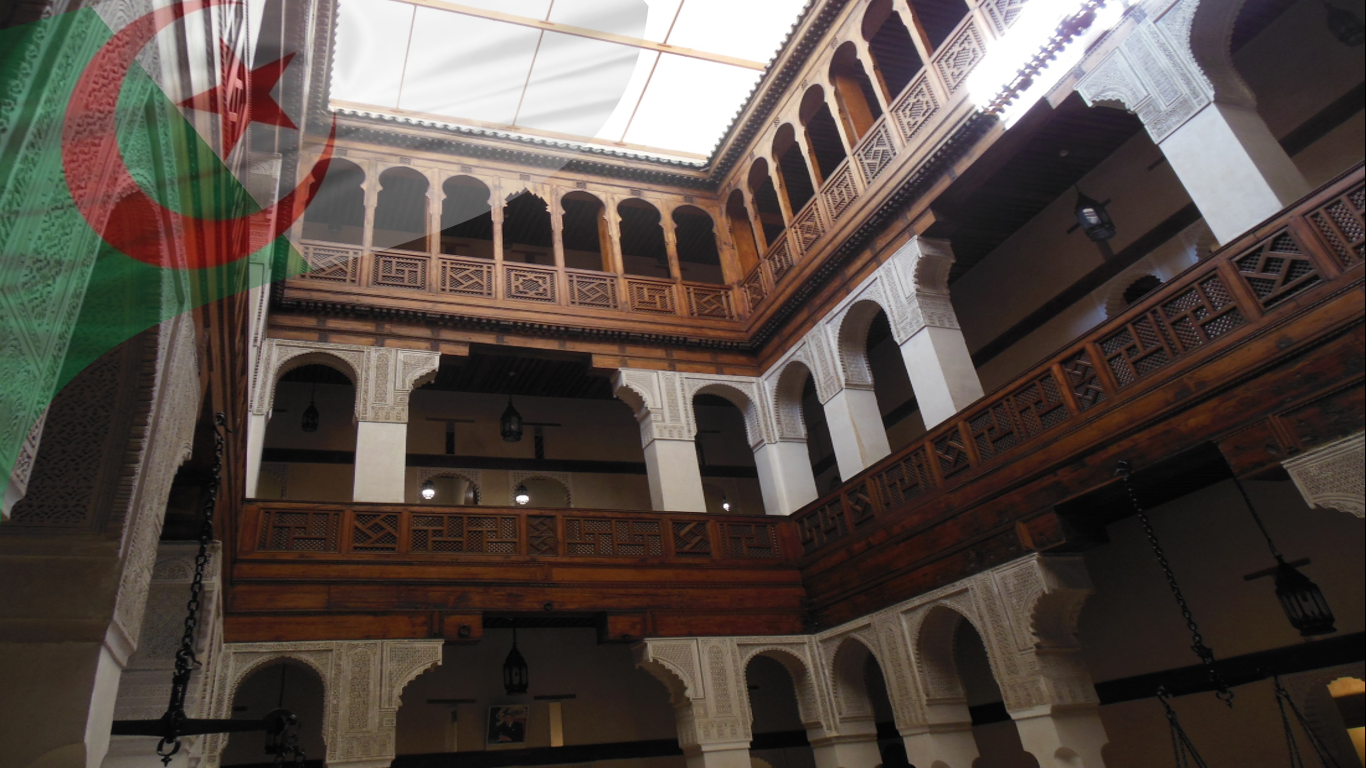Continuing from last week with the Syrian scene, great things are happening. Though there are many major developments in the region, as Trump’s deal of the century still rules the headlines and it seems the backdoor facilitation of the deal is well ongoing, resistance is showed. Resistance to the most blatant and outraging aggressions, and on levels most astonishing.
This week an ordinary Syrian citizen, Fatḥū al-Barḥū (in some versions Fatḥī al-Barḥū), a citizen not only his name, but even his hometown Bi’r al-Bū‘āṣī was unknown even Syrians became a hero of the news, and not only in Syria. A man, who seeing an American armed patrol passing through his simple little town not only joined the locals defending the Syrian soldiers and preventing the Americans from passing, but took down the American flag from one of the vehicles and openly confronted the American soldiers. The scandal soon lead up to a clash with the trespassers, which though left one Syrian citizen dead, stopped the American convoy and forced them to leave to where they came from. This incident is like nothing in the huge and complex Syrian equation, but in fact shows a lot about Syrian nature and current realities. As they say a picture might say more than a thousand words, this little incident in the mostly Kurdish Eastern Syria shows more than most of the evaluations and analysis in the research centers.
All this going on as the Syrian Army secures even bigger gains in Idlib regardless of the ever growing Turkish interference. As the Turkish leadership grows more and more desperate to prevent the inevitable the reasons and true nature of the whole Syrian crisis become clearer every day. It is indeed puzzling to see that Turkey not only arms openly the terrorist militias in Syria now, but even moves it forces in and threatens to wage an open war, while suffering its first officials casualties by the Syrian Army. Why is Erdoğan so desperate and why is he willing to risk even more on his long gamble even more, instead of accepting the realities? And why Israel is equally desperate to provoke Syria?
While the outer aggression by Turkey, Israel and the Americans seem to be more pressing the Syrian Army keeps going and liberating more lands. It has its eye on Bāb al-Hawā, the most important border crossing with Turkey even beyond Idlib. And the daily details show a lot from the secrets how Syria stayed resisting all these years, far from all the accusations of being a simple pawn in the hands of its allies.
One wishes to understand Syria, but in many ways also that part of the world sometimes has to depart from the big analysis and see things through the eyes of the everyday heroes. Heroes, like Fatḥū al-Barḥū.
A clash in al-Qāmišlī
It was on 12 February 2020, when an American patrol was cruising around in al-Qāmišlī city in the northeastern part eastern province of al-Ḥasaka. This part of Syria lives in complex realities, especially the city of al-Qāmišlī. The city itself and some essential parts of the province stayed under direct control of the Syrian state even during the long years of the war against Dā‘iš, while most of the countryside fell, and was later taken over by the so called “Qasad” (Syrian Democratic Forces). Eventually under the pretext of fighting the terrorist organization, which was only expanding in Syria under American interference and small pockets still take shelter under the American presence in at-Tanaf in the south, the American moved in hiding behind Qasad and set up a number of illegal military bases. After the last Turkish offensive in October against Qasad, which with much truth to it Turkey accuses to be an extension, a local version of the Kurdish PKK, Washington chose not to protect this proxy organization and left most its positions. The Syrian Army moved in and took over most of the countryside in the East, only to soon experience that the Americans returned from Iraq, yet this time they position themselves right along the oilfields. The dual aim is to take the oil and therefore revenues for its presence, but also to deny the Syrian state from these field to serve there economic war on Damascus. Soon, however, the situation was further complicated by the Russian presence, who in one hand negotiating between the Syrians and the Turks, while on the other backing up the Syrians against further American encroachment, also put up military bases in the East. Therefore every map drawing on the situation is somewhat fictitious. The everyday life in most of the countryside returned to the Syrian state, especially around the bigger cities, with regular Syrian checkpoints, while the Americans are present in some 22 positions around the oilfields and take regular random patrols in the neighborhood.
On that day one of these patrols leaving al-Qāmišlī chose to pass the small town of Hirbat ‘Ammū, where they confronted a Syrian checkpoint. And that lead to a clash. This is not the first time a similar thing happened. Only on 5 February a similar incident was reported in Tall Tamr in the same province, where the Syrian Army eventually forced the American patrol to retreat. In Hirbat ‘Ammū, however, the American troops in a rather arrogant way insisted that they will cross, even by force. This lead to the confrontation between the Syrian soldiers and the Americans, after which local residents flocked to surround patrol and show support for their own troops.
Though accounts vary somewhat, by the most shared version in the heat of the showdown, as Syrian soldiers tried to distance citizens from the Americans to prevent violence things started to get out of hands and one Syrian soldier jumping on one of the American vehicles put on it a Syrian flag. The Americans shot him, or shot at him, which lead to a fight, where locals started to throw rocks and flammables to the American carriers, but also opened fire at them. The Syrian soldier soon took defensive positions and also opened fire to cover the civilians. At the end the Americans called for reinforcements, which came, and passing American planes allegedly bombed the neighborhood of the clash. The video here shows that the Americans in their armed vehicles were showering the local houses with fire. In the following fight one Syrian civilian died and two got wounded.
After some time Syrian forces and a Russian patrol rushed to the site and intervened. The American patrol eventually backed off and withdrew without crossing the town. Locals flocked to complain to the Russian soldiers, which produced a striking scene. First of all locals, though surrounding the few Russian soldiers completely, had no problem with their presence. Quite the contrary, they trusted them for their help. An also in contrast to the Americans, the Russian soldiers did not need the help of translators, but could talk to the locals, even if in a basic level.
This video also shows that locals were hardened by recent years and are armed. While the incident shows that they are not afraid at all, even from the Americans. The incident, though the town of Hirbat ‘Ammū and the surrounding villages that also witnessed clashes that day might bare little significance, in a nutshell showed a lot about the nature of the current Syria crisis. And demolished much of the myths tirelessly built around for years in the media. This did not come as an isolated event, since it happened before, and two days later in the same area the Americans pulled the same audacity once again, right in the same village, only meet the same result as local townsfolk flocked to support the local garrison.
Who is Fatḥū al-Barḥū?
As Syria faces so many clashes today and finally good news are pouring in every day as areas in Idlib are being liberated the event might would have slipped attention. Though the events went viral instantly in the social media and after a day even in the Arab channels. But it was one man, who incorporated all what happened that day and became a pride of many Syrians. He is Fatḥū al-Barḥū, a local citizen of the town of Bi’r al-Bū‘āṣī, who according to the accounts is a simple cleaner of the al-Qāmišlī municipality, the father of six children. He was present at that day and a video about made him a smaller legend. The video here shows that he took down the American flag from one of the armored cars and walking around with it shouted with the American soldiers, who seemed rather frightened by him. This simple citizen, obviously unarmed and from very humble standing posed the question what the rest of the world should have asked in his stead from the Americans: “What matter do you have in this country here?”
What astonished everyone is how this simple unarmed man took the courage to shout at the Americans and take down their flag, which obviously put him into danger, since it was documented in a number of cases that the Americans killed civilians in Iraq and Syria. That standing also encouraged many and broke the myth of invincibility for the American soldiers, who could not handle this simple man, nor could they talk to him. In the later interviews to Lebanese al-Mayadeen and Syrian Samā channels it shows that is a very simple man, yet the conviction of resistance and patriotism lives vividly in him. The same virtues politicians and even less talented advisors, as we saw last week, like to talk about, but lives in such people. Even more significant that in his interviews, just like the locals flocking around the American patrol, highly praised the Syrian Army and President. But why is this so important? And in what ways it served as groundbreaking for all those chose to listen?
In 2011 the crisis of Syria started allegedly by peaceful protests against the government, despite the fear of the army and security apparatus. Though that is largely a myth and the reality is very far far from it, this was the official narrative the West, both politics and the media took. That is how the Syrian Army was labeled “regime forces”, “Asad troops”, “Asad militias” and all the recurring labels, while all intervention to the Syrian state affairs – a clear violation of the UN principals – were justified as “protecting the civilians from the regime”. And of course the ultimate solution for years was suggested to be the American intervention, which was hanging over Syria for years. Both under Obama and Trump. Yet in this incident locals flocked to support the few Syrian soldiers at the checkpoint. Meaning that after years of talking about American soldiers saving the civilians from the “regime forces”, now the Syrian civilians chose to “save” the Syrian soldiers from the Americans. And here we have to stress that by all accounts the Americans primarily clashed with the town people, not the Syrian troops. Which allegedly made them to call for air strikes.
All the more important where this all happened. This part of Syria, the East has a substantial Kurdish population, which made the Qasad able to find a foothold here. The Syrian state was in large part absent in the last few years in this area, especially in the villages. For years now Washington projected an image that it only protects the Kurd as legal minority and promotes their rights, which is partly represented by Qasad. Now it shows that locals have little adoration for this idea and they detest the American presence as much as their are adamant to their Syrian identity. Even those, who chose to join Qasad mostly chose to re-evaluate the situation after the Americans clearly betrayed them. That is why now Qasad conducts secret meeting with the Syrian leadership to ask for more help, which shows a gradual shift in their position. Washington might claim that they have Qasad as their ally, but most of the leadership they are portraying themselves with, like the infamous Mazlūm Kobānī are not from Syria, and the realities on the ground are very different.
And here would anyone suggest that the locals are only praising the Army for fear, should be reminded that these people were ready to fire on fully armed American soldiers having no chance. Do these people look afraid?
Or if some would suggest that these are only local militias, that is very doubtful, as Fatḥū al-Barḥū, the very person, who became the hero of the matter is very likely of Kurdish descent by his name. Yet he speaks Arabic and obviously highly devoted to the state.
This is the nature of the ordinary Syrians, who in large chose to resist all hardship. That legendary stubborn Syrian conviction was the backbone, upon which the Syrian state stood for years, and by which now turns the table around. And that famous Syrian nature showed in Idlib this week as well.
The roads of Idlib.
After liberating Sarāqib last week all presumed that soon the Syrian Army will head to Idlib, now standing only some 8 kilometers from the city. Yet this week was busy liberating the last sections of the M5 highway connecting Aleppo to Damascus. Which by 13 February became fully under the control of the Syrian Army.
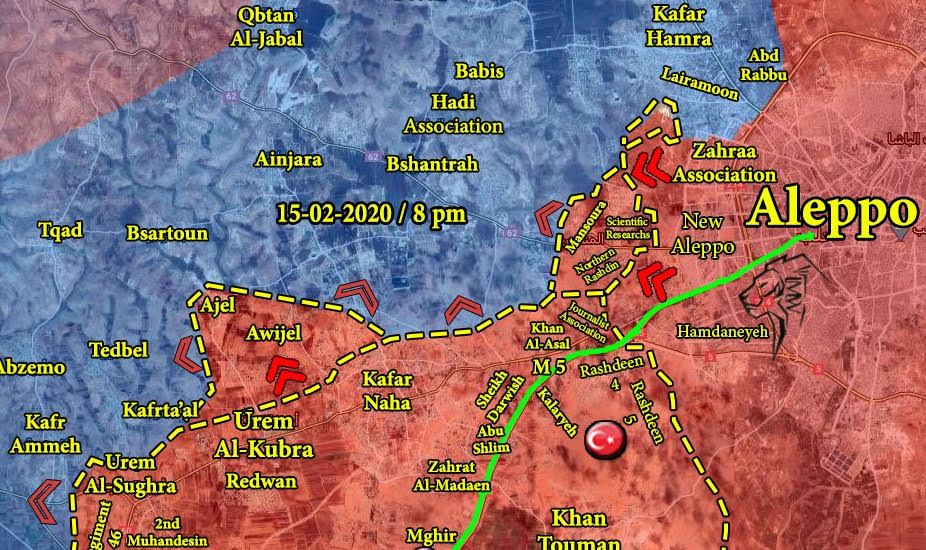
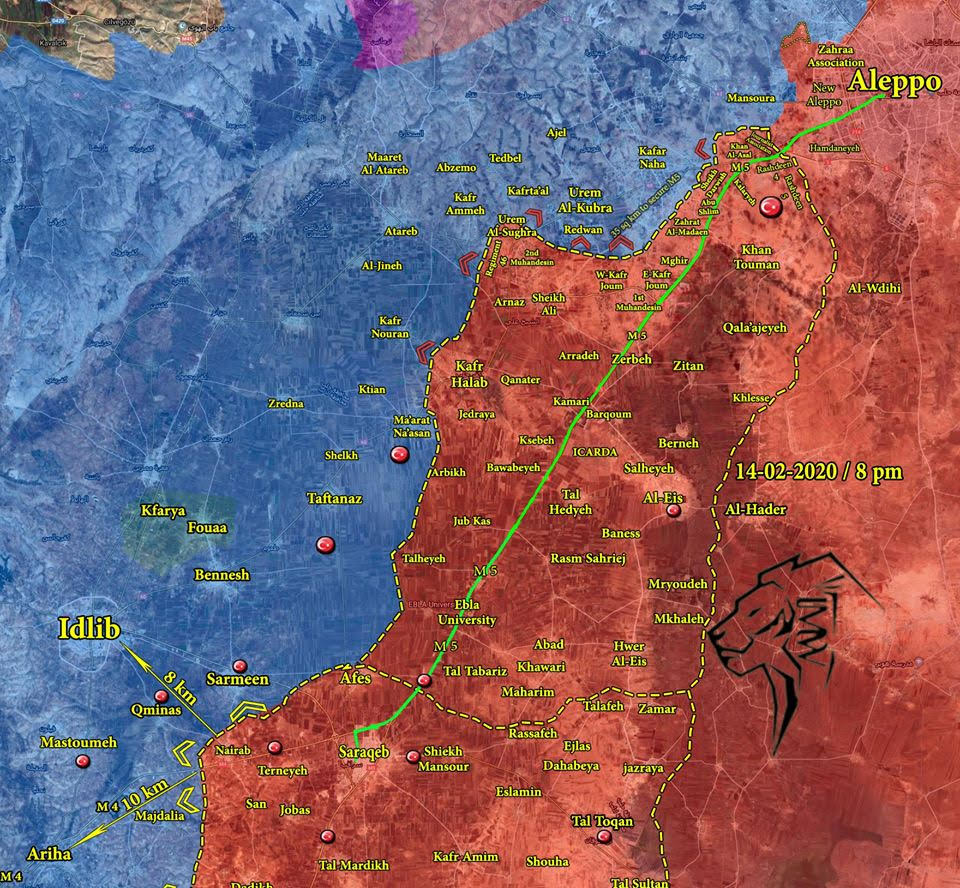
In the same way the Syrian Army faced the biggest pressure in the outskirts of Aleppo repelling several attacks by the terrorists, and finally managed to liberate Hān al-Asal. The very town where the first chemical incident happened in Syria in 2013, where militants used such means against the Army. With the ongoing progress of the Syrian Army comes joy and many happy scenes, like when Syrian reporter Šādī al-Ḥalwī danced with his colleagues along the liberated M5 highway under a street sign of Dā‘iš saying “Songs are sin”.
Or when Syrian businessman Fāris Šihābī showed a message at the liberated gates of Aleppo, showing what Syrians really faces during the long years of the war. What most in the West never saw, or chose not to see.
The main concern in Idlib is not the presence of the armed organizations anymore, as their lines are rapidly collapsing, regardless all the support they get from Turkey. As we saw last week Ankara decided to get involved directly, and when at an observation post Turkish forces decided to open fire on the Syrians the response was an artillery shelling, leaving 6 Turkish troops dead. This week it was escalating even more. After several claims by the Turkish leadership that they retaliated with deadly force all these reports were refuted and still there is no evidence at all about this. Meaning the Turkish leadership desperately tries to save face on the home front. The incident was used as a justification for even more support, but it was getting ever more clear that the Syrian Army will not back off this time. On 11 February a Turkish column consisting several tanks was directly targeted and shelled by the Syrian artillery. That left another 5 Turkish soldiers dead.
Ankara once again claimed that it hit back severely, with once again no evidence. It was noticeable, however, that Russian in large refrained from commenting these developments. This lead Erdoğan to address the Turkish Parliament the day after promising to hit back with full force against the Syrian Army if just one more Turkish soldier gets killed – in a way admitting that this hasn’t happened yet -, but also that he is constant contact with the Russians. Though some of the accusations were faced directly against Moscow. As a final resolution Erdoğan gave time until the end of February to return behind the so called de-escalation zones stimulated in Sochi, or otherwise the Turkish Army will push the Syrians back. Both are completely unrealistic at this point. The Syrians will not give up their gains, but with the Russians present in the frontlines Turkey cannot push them back without an all out war. Suggesting a slow and painful hit-and-run war, where both sides sometimes hit each other, while officially maintaining that they are not fighting.
That is exactly what happened, as they provided anti-air missile to their militias, which on 11 February shot down a Syrian military helicopter, killing 4 on board. The same thing repeated on 14 February, also presumably killing the whole Syrian crew. These are painful hits, however, it is noticeable that so far the Turkish Army refrained from a direct offensive, and hid behind their militias, which is the official line which their commentators follow. This, however, clearly does not stop the Syrian offensive now, and after widening the area around Aleppo and securing the M5 highway the only question is just where the next phase will come.
But why Erdoğan is so reluctant to change course and endeavor to an even bigger gamble? The recent remarks of the Turkish President are revealing, and that is the same tone coming now from most Turkish analysts in the Arabic language media. Turkey believed its NATO and Gulf allies from 2011 on and chose to arm, train and support radical militia organization, just like the so called “Syrian Oppositional Coalition” for long years. Which’s previous leader recently admitted that he is a Turk, and lead the Syrian Opposition as a Turk. Gradually all this Western-Gulf support has vaporized. This shows in the reopening of the Emirati embassy in Damascus, the incredible shift in tone in the Gulf media about the Syrian Army, or that the Syrian delegation was invited to the emergency Arab League summit in Amman about the Trump deal.
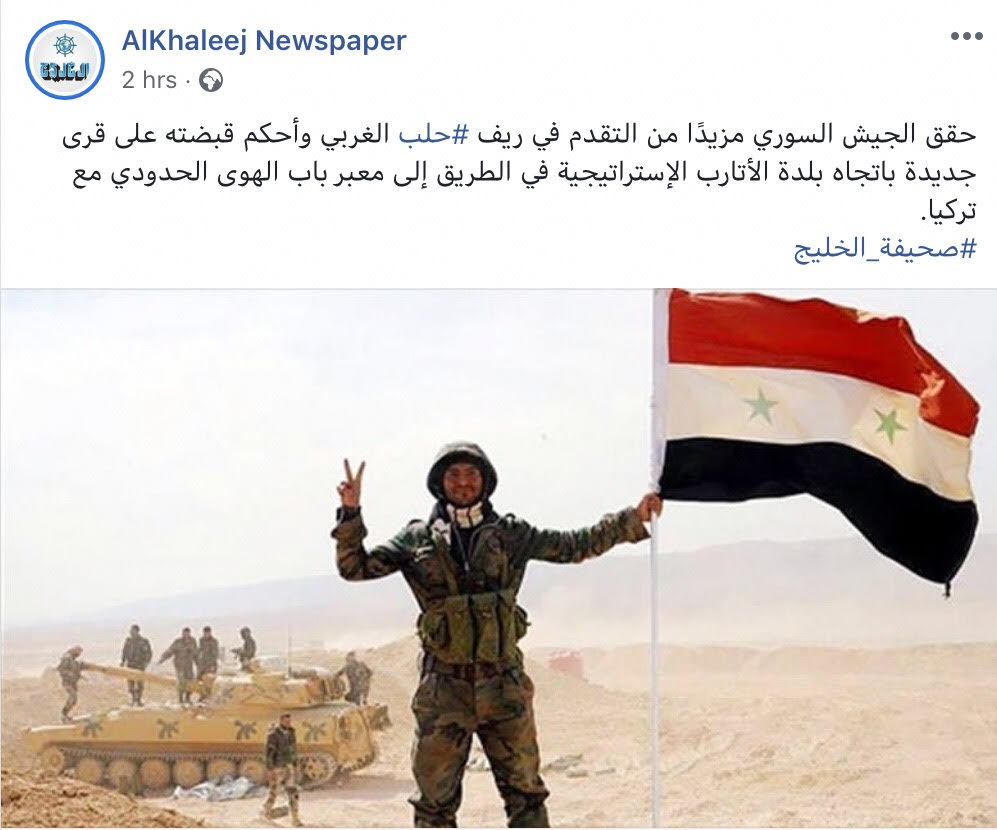
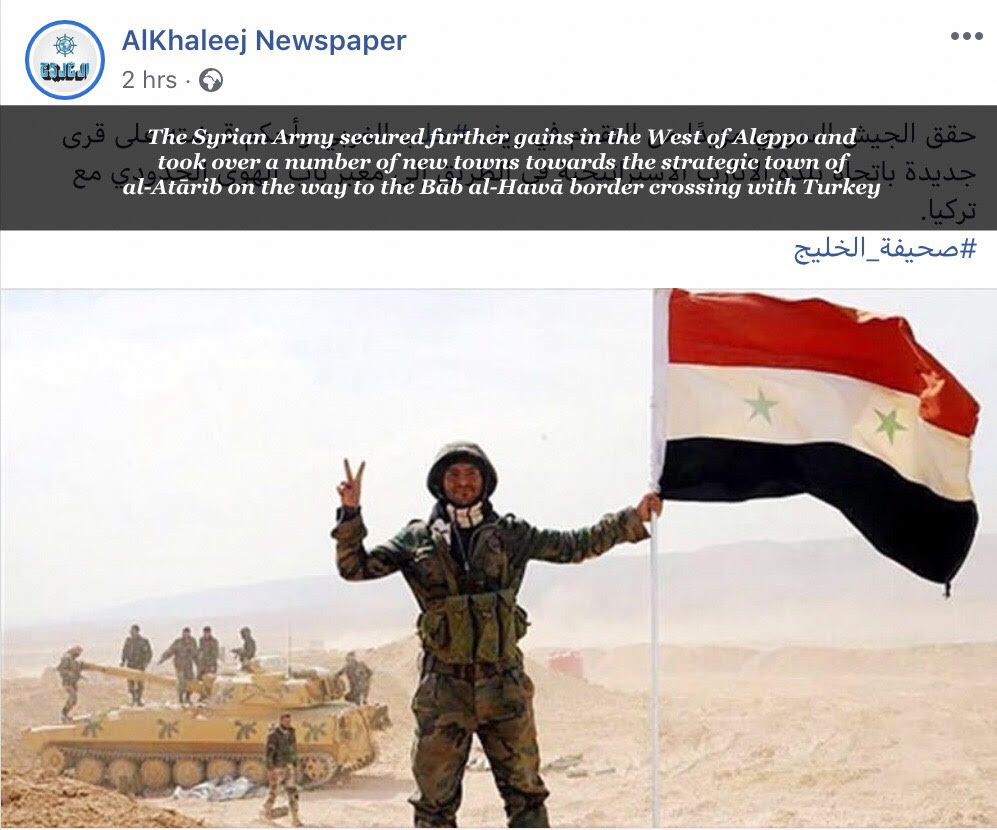
All this points to the fact that the Syrian government survived against all odds and now its coming back the Arab scene. Many of the militias Turkey trained and built were invented for much more longterm projects, which are no closing down. If the Syrian state reinstated itself all along the border these militias have only one place to go: Turkey. With the Syrian Army closing on the Bāb al-Hawā crossing that it a close reality.
One solution would have been to transport them to Libya, but that option is getting closed now, as the international resistance is growing. That comes from almost all regional states, that is present even at the Qatari allies, but the biggest pressure is coming from Europe, since most EU powers are not keen to see these radicals arriving to Libya, from where they can soon arrive to the EU.
Therefore the last resort being to keep these radicals inside Syria as long as possible. The more die by the hands of the Syrian Army the less the Turkish authorities will have to face in Turkey. That is why Erdoğan said: “Any fight Turkey does not wage inside Syria it shall soon wage it within its own borders”. In this equation the sacrifice of arms and equipment is a little price, but the loss of Turkish soldiers and so far the inability to respond to that makes this path very questionable now. The matter is not that this is a tactical decision, but it is a result of the lack of better option.
Heroes and the traitors
Indeed much of the Middle Eastern media held the Syrian situation in focus this week. For in one hand the Syrian Army was progressing rapidly, and the other that a major confrontation is unfolding between the Syrian and the Turkish armies. Exploiting this matter, and the tension growing between Ankara and Moscow the Americans try to improve their relations with Turkey now. Which might shuffle the cards once again, though at this point that is a small possibility.
All together the prospects are looking grim for the Middle East now, as Syria and Iraq still sees war and the end seems far. On the grand scale it would appear that more and more are leaving the resistance and make pacts with the West. Like the Chairman of the Sudanese Interim Council, who met with Netanyahu and is not working of normalization with Israel. By which he even surprised his own government. Or the Saudis, who in this week for the first time officially hosted an Israeli delegation. Behind these events, however, there is the same current, the Saudi-Emirati tandem, since they are the main supporters of the current Sudanese leadership, and they are pushing Khartoum.
Yet this week’s heroes were not the main decision maker, but those, who are hardly known. That applies in large and small, as the two most talked about persons in the Arab world this week was Fatḥū al-Barḥū, the Syrian cleaner, who faced the Americans with bare hands; and Marzūq al-Ġānim, Speaker of the Kuwaiti Parliament, who in the Amman emergency Arab League summit place the Trump plan, where most feel it in the region.

